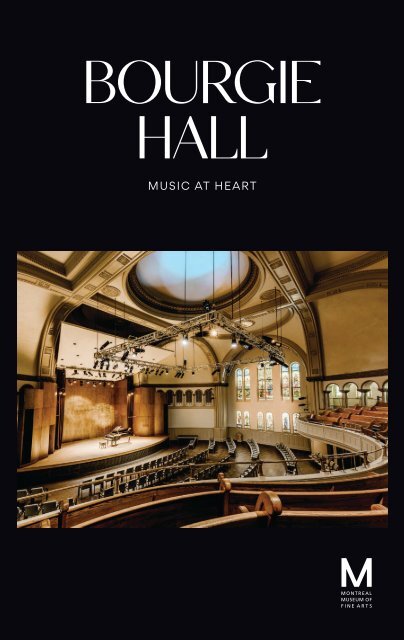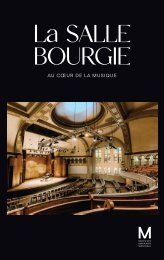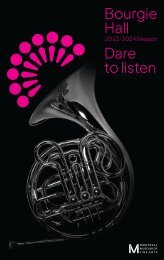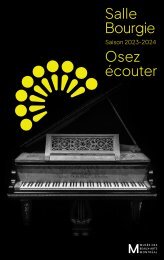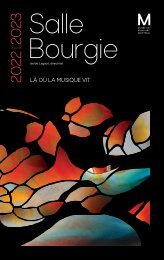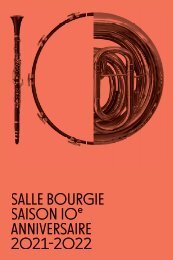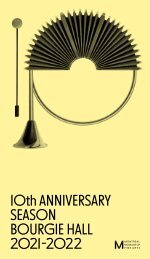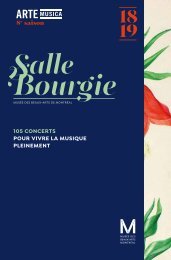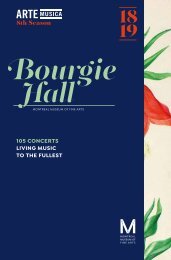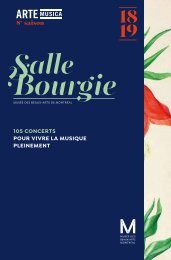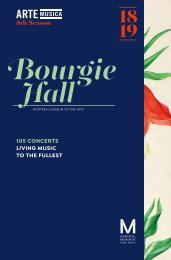You also want an ePaper? Increase the reach of your titles
YUMPU automatically turns print PDFs into web optimized ePapers that Google loves.
BOURGIE<br />
HALL<br />
MUSIC AT HEART
Cover<br />
<strong>Bourgie</strong> <strong>Hall</strong>, interior view<br />
Photo: Julia Marois<br />
<strong>Bourgie</strong> <strong>Hall</strong> and the Claire and Marc <strong>Bourgie</strong> Pavilion<br />
of Quebec and Canadian Art of the MMFA<br />
Photo: Paul Boisvert
SUMMARY<br />
4.<br />
BOURGIE HALL<br />
AT A GLANCE<br />
6.<br />
ARTISTIC VISION AND<br />
MUSICAL PROGRAMMING<br />
12.<br />
RENOWNED PERFORMERS<br />
AT BOURGIE HALL<br />
14.<br />
INSTRUMENT COLLECTION<br />
18.<br />
EXCEPTIONAL TIFFANY<br />
WINDOWS<br />
20.<br />
HISTORY OF THE HALL<br />
30.<br />
SEATING PLAN<br />
Texts: Claudine Jacques<br />
Project coordin<strong>at</strong>ors: Claudine Jacques and Coralie Baudet<br />
<strong>Bourgie</strong> <strong>Hall</strong> directors: Caroline Louis and Olivier Godin<br />
Texts revisions: François Zeitouni, Claude Nadon and Trevor Hoy<br />
Transl<strong>at</strong>ion: Le trait juste<br />
Graphic design: Corinne Bève
4<br />
BOURGIE HALL<br />
BOURGIE HALL<br />
AT A GLANCE<br />
<strong>Bourgie</strong> <strong>Hall</strong>, interior view<br />
Photo: Julia Marois
<strong>Music</strong> At <strong>Heart</strong><br />
5<br />
Inaugur<strong>at</strong>ed in<br />
September 2011<br />
465-se<strong>at</strong> capacity<br />
divided between orchestra<br />
and balcony levels<br />
Loc<strong>at</strong>ed in the heart<br />
of one of Canada’s most<br />
culturally and artistically<br />
dynamic cosmopolitan cities<br />
Conceived and<br />
designed for solo<br />
recitals and chamber<br />
music<br />
Outstanding acoustics<br />
for voice as well as for instruments<br />
Develops a varied<br />
and accessible<br />
programming,<br />
offering rich and surprising<br />
encounters to a wide range of<br />
audiences<br />
Builds bridges<br />
with the visual arts<br />
in conjunction with the Montreal<br />
Museum of Fine Arts<br />
Presents over<br />
100 concerts annually<br />
Is home to the largest<br />
collection of religious<br />
Tiffany stained-glass<br />
windows in Canada<br />
Highlights a unique<br />
collection of valuable<br />
keyboard instruments<br />
Fe<strong>at</strong>ures a wide variety<br />
of musical genres:<br />
classical music from all eras, jazz,<br />
music of global cultures, crossover<br />
performances between various art<br />
forms, as well as concerts for youth<br />
audiences<br />
Provides the public<br />
with a high-quality<br />
cultural offer <strong>at</strong><br />
affordable prices
6<br />
BOURGIE HALL<br />
ARTISTIC VISION<br />
AND MUSICAL<br />
PROGRAMMING<br />
A key venue on the Quebec<br />
music scene<br />
Since its opening, <strong>Bourgie</strong> <strong>Hall</strong> has enjoyed exceptional<br />
beginnings and revolutionized the concert scene in the city<br />
by offering the public outstanding performances. It was<br />
initially expected th<strong>at</strong> some thirty concerts per year would be<br />
presented, but the venue’s qualities quickly made it one of the<br />
most sought-after halls in Quebec: today, it hosts almost 200<br />
events each season. <strong>Bourgie</strong> <strong>Hall</strong> is known for the diversity<br />
of musical genres it presents, and the quality and originality<br />
of its programming—designed for both seasoned and new<br />
music lovers. Combined with its close ties with the Museum’s<br />
exhibitions and collections, the support and opportunities it<br />
provides to young performers, and the cre<strong>at</strong>ion of new music,<br />
it has established itself as one of Canada’s most important<br />
concert music presenters.<br />
Due to its intim<strong>at</strong>e <strong>at</strong>mosphere, its size perfectly suited to<br />
recitals and chamber music, and its exceptional acoustics, the<br />
hall is an ideal venue for soloists, small ensembles, and chamber<br />
orchestras. For its jazz and world music concerts, the hall also<br />
boasts a st<strong>at</strong>e-of-the-art sound system.<br />
The Tallis Scholars<br />
December 13, 2022<br />
Photo: Claudine Jacques
<strong>Music</strong> At <strong>Heart</strong><br />
7<br />
“When <strong>Bourgie</strong> <strong>Hall</strong> opened its doors in 2011,<br />
we did not yet guess how much it<br />
would change musical life in Montreal.(...)<br />
We could no longer imagine Montreal<br />
without <strong>Bourgie</strong> <strong>Hall</strong>.”<br />
CAROLINE RODGERS, LUDWIG VAN MONTRÉAL
8<br />
BOURGIE HALL<br />
The Arte <strong>Music</strong>a<br />
Found<strong>at</strong>ion<br />
Diversity, Excellence<br />
and Accessibility<br />
The Arte <strong>Music</strong>a Found<strong>at</strong>ion, established<br />
in September 2007 by philanthropist and<br />
businessman Pierre <strong>Bourgie</strong>, has the mission to<br />
organize and present musical activities within<br />
the Montreal Museum of Fine Arts (MMFA),<br />
specifically in <strong>Bourgie</strong> <strong>Hall</strong>. Programming<br />
follows three main axes: the production and<br />
present<strong>at</strong>ion of concerts, the support to<br />
promising young artists and the development<br />
of audiences through educ<strong>at</strong>ional and<br />
medi<strong>at</strong>ion activities. It draws its inspir<strong>at</strong>ion<br />
from the various art forms present <strong>at</strong> the<br />
MMFA, relaying the encyclopaedic world th<strong>at</strong><br />
it contains. Surprising encounters, as well as<br />
links nurtured with other artistic disciplines<br />
such as liter<strong>at</strong>ure, the visual arts, dance, and<br />
film have been an integral part of <strong>Bourgie</strong> <strong>Hall</strong>’s<br />
programming since its opening. This has made<br />
it possible to present an innov<strong>at</strong>ive and unique<br />
programming to the public, sometimes in the<br />
exhibition rooms themselves. In fact, several<br />
musical activities had already taken place<br />
in situ a few years before <strong>Bourgie</strong> <strong>Hall</strong> was<br />
inaugur<strong>at</strong>ed.<br />
Since its opening, the hall has relied on<br />
a varied and audacious programming of<br />
exceptional artistic quality, quickly forging its<br />
own distinctive personality and developing<br />
a compelling branding. The concerts offered<br />
cover many centuries of music, enabling<br />
music lovers to enjoy a gre<strong>at</strong> variety of musical<br />
trends.<br />
The quest for excellence has always guided<br />
programming choices <strong>at</strong> <strong>Bourgie</strong> <strong>Hall</strong>. Whether<br />
rising stars or firmly established and critically<br />
acclaimed musicians, they are selected by<br />
<strong>Bourgie</strong> <strong>Hall</strong> on the basis of their immense<br />
talent. Its programming comprises 50 % of<br />
Canadian artists and 50 % of intern<strong>at</strong>ional<br />
artists: thus today, almost the entire Montreal<br />
and Quebec musical milieu is linked in one<br />
way or another to the activities taking place <strong>at</strong><br />
<strong>Bourgie</strong> <strong>Hall</strong>. The venue has had a considerable<br />
impact on the musical scene in Montreal,<br />
Quebec and Canada, as well as on the careers<br />
of many artists.<br />
Offering affordable concerts to a large number<br />
of listeners from diverse backgrounds, enabling<br />
them to enjoy the venue’s musical offerings is a<br />
priority for <strong>Bourgie</strong> <strong>Hall</strong>’s directors. Well-rooted<br />
in its community through accessibility and<br />
educ<strong>at</strong>ional programmes, it has established<br />
numerous partnerships with various cultural<br />
organiz<strong>at</strong>ions and social groups, thus ensuring<br />
th<strong>at</strong> <strong>Bourgie</strong> <strong>Hall</strong> remains accessible to all.<br />
Djely Tapa, voice<br />
2022-2023 season launch, May 3, 2022<br />
Photo: Frédéric Faddoul
9
10<br />
BOURGIE HALL<br />
Prestigious Partners<br />
Daring Projects<br />
<strong>Bourgie</strong> <strong>Hall</strong> works with a vast network of<br />
recognized artistic partners, both from<br />
Quebec and Canada as well as intern<strong>at</strong>ionally,<br />
to diversify its collabor<strong>at</strong>ions. It joins forces<br />
with the Palazzetto Bru Zane, <strong>Music</strong>ians<br />
from Marlboro, the Queen Elisabeth <strong>Music</strong><br />
Chapel (Belgium), the Royaumont Found<strong>at</strong>ion,<br />
Koerner <strong>Hall</strong> of the Royal Conserv<strong>at</strong>ory of<br />
<strong>Music</strong> in Toronto, Early <strong>Music</strong> Vancouver, the<br />
Club musical de Québec, the Festival Bach<br />
Montréal, the Intern<strong>at</strong>ional Festival of Films<br />
on Art (Le FIFA), the Orchestre symphonique<br />
de Montréal, the Orchestre Métropolitain, and<br />
the Festival intern<strong>at</strong>ional de la littér<strong>at</strong>ure (FIL),<br />
among many other productive collabor<strong>at</strong>ions.<br />
<strong>Bourgie</strong> <strong>Hall</strong> hosts the annual Opus Awards<br />
Gala organized by the Conseil québécois de<br />
la musique, an important event th<strong>at</strong> brings<br />
together key players in the music industry<br />
and rewards musical excellence in Quebec.<br />
Furthermore, since its opening in 2011,<br />
<strong>Bourgie</strong> <strong>Hall</strong> has welcomed the Concours<br />
musical intern<strong>at</strong>ional de Montréal every year.<br />
This renowned event, which showcases some<br />
of the world’s most talented young artists<br />
in voice, violin and piano, has proven to be<br />
a veritable stepping stone for many highly<br />
talented performers. For some, including<br />
Charles Richard-Hamelin, Philippe Sly and<br />
Be<strong>at</strong>rice Rana, the competition proved to<br />
be the beginning of a brilliant intern<strong>at</strong>ional<br />
career.<br />
Many inspiring projects have emerged over<br />
the years. They include the performance in<br />
concert of all of J.S. Bach’s over 200 sacred<br />
cant<strong>at</strong>as, in 77 concerts spread over eight<br />
seasons between September 2014 and March<br />
2023. A first in Canada, this multi-year project<br />
was a formidable adventure as well as an<br />
exceptional showcase for Montreal, reflecting<br />
its st<strong>at</strong>us as a musical metropolis. Involving<br />
numerous acclaimed artists and ensembles<br />
from the Quebec and intern<strong>at</strong>ional musical<br />
communities, these concerts fe<strong>at</strong>ured 33<br />
musical ensembles (22 from Quebec, one<br />
Canadian, four American and six European)<br />
and four professional choirs, as well as 158<br />
vocal and instrumental soloists and 321<br />
instrumentalists, under the direction of 29<br />
conductors from here and abroad. Other<br />
large-scale projects include the performance<br />
by Canadian pianist Louis Lortie of Beethoven’s<br />
32 piano son<strong>at</strong>as.<br />
Left picture<br />
Orchestre symphonique de Montréal<br />
Conductor: Rafael Payare.<br />
September 25, 2022. Part of the<br />
complete J.S. Bach cant<strong>at</strong>as cycle.<br />
Photo: Frédéric Faddoul<br />
Right picture<br />
<strong>Bourgie</strong> <strong>Hall</strong> lobby<br />
2022-2023 season launch, May 3, 2022.<br />
Photo: Frédéric Faddoul
<strong>Music</strong> At <strong>Heart</strong><br />
11<br />
<strong>Music</strong>al Cre<strong>at</strong>ion<br />
<strong>at</strong> <strong>Bourgie</strong> <strong>Hall</strong><br />
Wh<strong>at</strong> are the benefits<br />
for artists?<br />
Already beginning in the 2013–2014 season,<br />
the Arte <strong>Music</strong>a Found<strong>at</strong>ion established a<br />
new fund for musical cre<strong>at</strong>ion, enabling music<br />
inspired by a visual work on display in the<br />
Museum to be cre<strong>at</strong>ed in <strong>Bourgie</strong> <strong>Hall</strong>, on a<br />
regular basis. Acting, so to speak, as a vessel<br />
for the cre<strong>at</strong>ion of new works, <strong>Bourgie</strong> <strong>Hall</strong> has<br />
initi<strong>at</strong>ed several contemporary music cre<strong>at</strong>ion<br />
projects through commissioned works, thus<br />
allowing the public to hear pieces by both<br />
emerging and established Canadian, Quebec<br />
and intern<strong>at</strong>ional composers, including Elliott<br />
Carter, Maxime McKinley, Nicole Lizée, and<br />
Julien Bilodeau. This initi<strong>at</strong>ive strengthens the<br />
ties th<strong>at</strong> bind music to the visual arts, while<br />
offering musical experiences th<strong>at</strong> reflect the<br />
diversity of the MMFA’s collections. In recent<br />
years, <strong>Bourgie</strong> <strong>Hall</strong> has commissioned works<br />
by Barbara Assiginaak (Odawa First N<strong>at</strong>ion),<br />
Luna Pearl Woolf (Canada), Nicole Lizée<br />
(Canada), Ana Sokolovic (Canada/Serbia), and<br />
Adina Izarra (Venezuela), and has presented<br />
several concerts in tribute to Quebec composer<br />
Rachel Laurin.<br />
For artists, performing <strong>at</strong> <strong>Bourgie</strong> <strong>Hall</strong> has<br />
numerous advantages. <strong>Music</strong>ians appreci<strong>at</strong>e<br />
the human scale of the venue, its conviviality,<br />
its inspiring <strong>at</strong>mosphere, and the direct<br />
rel<strong>at</strong>ionship with the audience th<strong>at</strong> it fosters,<br />
gener<strong>at</strong>ing unforgettable moments of sharing.<br />
A skilled and dynamic team ensures the<br />
success of events taking place in the venue.<br />
The proximity of various services in the city’s<br />
downtown area, as well as numerous cultural<br />
and tourist activities, enhance <strong>Bourgie</strong> <strong>Hall</strong>’s<br />
<strong>at</strong>tractiveness.<br />
Wh<strong>at</strong> about our public?<br />
Montreal audiences make a significant<br />
difference: <strong>at</strong>tentive, interested, fond of<br />
culture and the performing arts, curious and<br />
knowledgeable, they are proud of this hall<br />
where they feel <strong>at</strong> home. Several audience<br />
members are deeply <strong>at</strong>tached to <strong>Bourgie</strong> <strong>Hall</strong><br />
and return on multiple occasions during the<br />
same season, which confirms the community’s<br />
interest in this unique venue. Because of close<br />
audience-performer proximity, visibility is<br />
optimal throughout the entire hall. In addition,<br />
sound quality is excellent on both the orchestra<br />
and the balcony levels.
12<br />
RENOWNED<br />
PERFORMERS AT<br />
BOURGIE HALL<br />
VIOLIN AND VIOLA<br />
Stéphanie-Marie Degand<br />
James Ehnes<br />
Isabelle Faust<br />
Gidon Kremer<br />
Antoine Tamestit<br />
Andrew Wan<br />
CELLO<br />
Emmanuelle Bertrand<br />
Christophe Coin<br />
Steven Isserlis<br />
Johannes Moser<br />
Jean-Guihen Queyras<br />
Stéphane Tétreault<br />
PIANO<br />
Pascal Amoyel<br />
Jean-Efflam Bavouzet<br />
Michel Béroff<br />
Christian Blackshaw<br />
Yefim Bronfman<br />
Kh<strong>at</strong>ia Buni<strong>at</strong>ishvili<br />
Philippe Cassard<br />
Jean-Philippe Collard<br />
David Fray<br />
Marc-André Hamelin<br />
André Laplante<br />
Louis Lortie<br />
Benedetto Lupo<br />
Anne Queffélec<br />
Be<strong>at</strong>rice Rana<br />
Charles Richard-Hamelin<br />
Alexandre Tharaud<br />
FORTEPIANO AND<br />
HARPSICHORD<br />
Kristian Bezuidenhout<br />
Ronald Brautigam<br />
Jean Rondeau<br />
Andreas Staier<br />
VOICE<br />
Ian Bostridge<br />
Julie Boulianne<br />
Karina Gauvin<br />
Philippe Jaroussky<br />
Marie-Nicole Lemieux<br />
Anne Sofie von Otter<br />
Andreas Scholl<br />
HARP<br />
Xavier de Maistre<br />
Valérie Milot<br />
GUITAR AND MANDOLIN<br />
Avi Avital<br />
Pepe Romero<br />
Anne Sofie von Otter, mezzo-soprano and<br />
Kristian Bezuidenhout, fortepiano<br />
November 7, 2022<br />
Photo: Claudine Jacques
13<br />
<strong>Bourgie</strong> <strong>Hall</strong> has <strong>at</strong>tracted some of today’s most outstanding<br />
intern<strong>at</strong>ional artists and ensembles; some have become regular<br />
guests over the years. The following is a list of renowned soloists<br />
who have performed <strong>at</strong> <strong>Bourgie</strong> <strong>Hall</strong>*:<br />
PERCUSSION<br />
Evelyn Glennie<br />
VIOLA DA GAMBA<br />
Jordi Savall<br />
FLUTE AND RECORDER<br />
Emmanuel Pahud<br />
Maurice Steger<br />
CONDUCTORS<br />
Rinaldo Alessandrini<br />
Jon<strong>at</strong>han Cohen<br />
Reinhard Goebel<br />
Bernard Labadie<br />
Kent Nagano<br />
Yannick Nézet-Séguin<br />
Hervé Niquet<br />
Rafael Payare<br />
Christophe Rousset<br />
ENSEMBLES<br />
Camer<strong>at</strong>a RCO (Royal<br />
Concertgebouw Orchestra)<br />
Concerto Italiano<br />
Ensemble Correspondances<br />
Les Talens Lyriques<br />
Les Violons du Roy<br />
London Handel Players<br />
Orchestre Métropolitain<br />
Orchestre symphonique<br />
de Montréal<br />
Orlando Consort<br />
Tafelmusik<br />
The Gesualdo Six<br />
The King’s Singers<br />
The Philip Glass Ensemble<br />
The Tallis Scholars<br />
JAZZ AND MUSIC OF<br />
GLOBAL CULTURES<br />
Kinan Azmeh<br />
Rémi Bolduc<br />
François Bourassa<br />
Lorraine Desmarais<br />
Chet Doxas<br />
Liu Fang<br />
Jacques Kuba Séguin<br />
Ranee Lee<br />
Lúnasa<br />
Charles McPherson<br />
Jean-Michel Pilc<br />
Marc Ribot<br />
Zal Sissokho<br />
Taurey Butler Trio<br />
Stéphane Wrembel<br />
Karen Young<br />
Camer<strong>at</strong>a RCO and<br />
Geoffroy Salvas, baritone<br />
March 28, 2023<br />
Photo: Pierre Langlois<br />
*This is not a comprehensive list.
14<br />
BOURGIE HALL<br />
INSTRUMENT<br />
COLLECTION<br />
1.<br />
<strong>Bourgie</strong> <strong>Hall</strong> houses and<br />
maintains a valuable collection<br />
of keyboard instruments,<br />
which are kept in top condition<br />
by experienced technicians.<br />
These instruments are heard<br />
in concert several times a year.<br />
Steinway Pianos<br />
<strong>Bourgie</strong> <strong>Hall</strong> houses two<br />
excellent Steinway pianos,<br />
ideal for recitals.<br />
Steinway Model D:<br />
9-foot Concert Grand Piano<br />
(2.74 m)<br />
for performances.<br />
Steinway Model B:<br />
7-foot Classic Grand Piano<br />
(2.11 m)<br />
for the rehearsal room.<br />
Fig. 1<br />
Steinway Model D<br />
Concert piano (9 ft)<br />
Photo: Claudine Jacques
<strong>Music</strong> At <strong>Heart</strong><br />
15<br />
2.<br />
The Érard Piano<br />
Manufactured in London in 1859,<br />
this Érard piano is fully represent<strong>at</strong>ive<br />
of the Romantic piano of the time of<br />
Schumann, Liszt, Wagner, Saint-Saëns<br />
and Fauré. This historical instrument was<br />
completely restored between 2009 and<br />
2011 by Claude Thompson and boasts an<br />
exceptional sound.<br />
3.<br />
The Fortepiano<br />
<strong>Bourgie</strong> <strong>Hall</strong>’s fortepiano was built in 2020<br />
in Maine (USA) by Rodney J. Regier.<br />
The instrument has proven to be highly<br />
popular with performers, who praise both<br />
its sound and its technical possibilities.<br />
The instrument is based on Viennese<br />
models by Conrad Graf and Ignaz<br />
Bösendorfer between 1820 and 1840,<br />
and which were known to Beethoven and<br />
Schubert. Its light, all-wood structure,<br />
strings and keyboard mechanism produce<br />
a clear, bright sound.<br />
Fig. 2<br />
Historical Érard grand piano<br />
(London, 1859), restored in 2009-2011<br />
by Claude Thompson (Montreal).<br />
Photo: Maxime Brunet<br />
Fig. 3<br />
Fortepiano<br />
built by Rodney J. Regier (2020, Maine),<br />
after instruments by Viennese makers<br />
Conrad Graf and Ignaz Bösendorfer (1820-1840).<br />
Photo: Tam Photography
16<br />
BOURGIE HALL<br />
4. 5.<br />
Two Harpsichords<br />
<strong>Bourgie</strong> <strong>Hall</strong> also owns two remarkable harpsichords:<br />
A 17th-century Italian-style instrument with a short octave<br />
and large compass built in 1975 by Rodney Myrvaagnes;<br />
An instrument in the 17th-century Flemish style of<br />
harpsichord-building made in 1984 by Keith Hill.<br />
Fig. 4<br />
Italian harpsichord<br />
built by Rodney Myrvaagnes<br />
(Boston, 1975), after a 17th-century<br />
Italian-style instrument by<br />
Johannes de Perticis (Florence).<br />
Photo: MMFA, Christine Guest<br />
Fig. 5<br />
Flemish harpsichord<br />
built by Keith Hill (Michigan, 1984),<br />
after an instrument by Ruckers<br />
(Antwerp), inspired by the<br />
17th-century Flemish style.<br />
Photo: MMFA, Christine Guest
<strong>Music</strong> At <strong>Heart</strong><br />
17<br />
6.<br />
The Clavicytherium<br />
The Opus 100 of Yves Beaupré, one of<br />
Canada’s most reputable makers of early<br />
keyboard instrument, this clavicytherium<br />
was designed in 2002 after an instrument<br />
by Albertus Delin from 1768, housed in the<br />
Kunstmuseum in The Hague. This unusual<br />
instrument has the particularity of being<br />
upright and has a single set of strings.<br />
7.<br />
Two Chamber Organs<br />
Finally, <strong>Bourgie</strong> <strong>Hall</strong> also houses two<br />
magnificent chamber organs both built by<br />
Hellmuth Wolff:<br />
A small chamber organ, built in 1958 and<br />
transformed into a positive organ in 1998. It<br />
has 51 keys and five registers;<br />
A large chamber organ with 12 stops, two<br />
manuals and a pedalboard. Built in Montreal<br />
for the organists Bernard and Mireille<br />
Lagacé, it was completely restored in 2011<br />
by Hellmuth Wolff and François Desautels to<br />
adapt it to the requirements of <strong>Bourgie</strong> <strong>Hall</strong>.<br />
Fig. 6<br />
Clavicytherium (“upright harpsichord”)<br />
by Yves Beaupré, Op. 100 (Montreal, 2002).<br />
After an instrument by Albertus Delin<br />
(1712-1771), built in 1768 and preserved <strong>at</strong><br />
the Kunstmuseum in The Hague.<br />
Photo: MMFA, Christine Guest<br />
Fig. 7<br />
Small chamber organ (Op. 1)<br />
built by Hellmuth Wolff (Switzerland, 1958),<br />
restored in 1998 by Hellmuth Wolff,<br />
Jens Petersen and Steve Sinclair.<br />
Photo: MMFA, Christine Guest
18<br />
BOURGIE HALL<br />
8. 9.
<strong>Music</strong> At <strong>Heart</strong><br />
19<br />
EXCEPTIONAL<br />
TIFFANY<br />
WINDOWS<br />
Among the hall’s 81 stained glass windows,<br />
which were fully cleaned and restored, 20<br />
come from the workshops of the Tiffany<br />
Glass and Decor<strong>at</strong>ing Company, including<br />
four huge windows nearly four metres high,<br />
which accentu<strong>at</strong>e <strong>Bourgie</strong> <strong>Hall</strong>’s spectacular<br />
look. These windows were commissioned in<br />
1896 for the American Presbyterian Church<br />
on Dorchester Street (today René-Lévesque<br />
Boulevard) and were produced mainly<br />
between 1897 and 1904, during the heyday<br />
of the famous New York firm. Following the<br />
merger of the two Presbyterian communities<br />
(Erskine and American) in the 1930s, and<br />
the subsequent demolition of the American<br />
Presbyterian church which housed them, the<br />
stained-glass windows were reinstalled in the<br />
Erskine and American Church in 1937 and 1938.<br />
These stained-glass windows carry the name<br />
of the founder of the studio, New York artist<br />
Louis Comfort Tiffany (1848–1933), a leader in<br />
American design who became famous for his<br />
Art Nouveau cre<strong>at</strong>ions and the striking light<br />
effects of his pieces.<br />
A large team worked under Tiffany’s leadership<br />
to cre<strong>at</strong>e them, including Frederick Wilson, the<br />
studio’s artistic director for nearly 30 years.<br />
At least five of the windows can be safely<br />
<strong>at</strong>tributed to Wilson. The <strong>Bourgie</strong> <strong>Hall</strong> Tiffany<br />
windows constitute one of only two of the<br />
firm’s commissions for Canada and one of<br />
the few surviving religious series by Tiffany<br />
in North America. They are characterized<br />
by a milky glass with iridescent, opalesque<br />
reflections. An innov<strong>at</strong>ive permanent<br />
backlighting system has been added—a first,<br />
on this scale—allowing audiences to admire<br />
the beauty of the windows during concerts.<br />
<strong>Bourgie</strong> <strong>Hall</strong> is an exceptional setting in which<br />
to display these stained-glass windows, which<br />
are part of the collections of the Montreal<br />
Museum of Fine Arts. Their value in the visual<br />
arts and their importance in the history of<br />
art are undeniable. They contribute to the<br />
architectural beauty and unique <strong>at</strong>mosphere<br />
of <strong>Bourgie</strong> <strong>Hall</strong>. In 2010, they benefitted from<br />
an unprecedented restor<strong>at</strong>ion by Françoise<br />
Saliou, under the supervision of the MMFA.<br />
Fig. 8<br />
Angel<br />
Louis Comfort Tiffany (1848-1933), designed by<br />
Frederick Wilson (1858-1932), Angel, <strong>Bourgie</strong> <strong>Hall</strong>, MMFA<br />
(formerly the Erskine and American Church), 1904-1905,<br />
leaded glass, made by Tiffany Studios, New York.<br />
MMFA, purchase.<br />
Photo: MMFA, Christine Guest<br />
Fig. 9<br />
Charity<br />
Louis Comfort Tiffany (1848-1933), designed by<br />
Thomas Calvert (1873- after 1934), Charity, <strong>Bourgie</strong> <strong>Hall</strong>,<br />
MMFA (formerly the Erskine and American Church),<br />
about 1901, leaded glass, made by Tiffany Glass and<br />
Decor<strong>at</strong>ing Co., New York. MMFA, purchase.<br />
Photo: MMFA, Christine Guest
20 BOURGIE HALL<br />
HISTORY OF<br />
THE HALL<br />
Origins:<br />
Historical Milestones<br />
Before it became a concert venue, <strong>Bourgie</strong> <strong>Hall</strong> was a place of worship named<br />
Erskine Presbyterian Church. Built in the l<strong>at</strong>e 19th century in the architecturally<br />
massive and powerful Romanesque Revival style complete with a gre<strong>at</strong> nave,<br />
the building recalls Europe’s medieval churches. Designed by Scottish-Canadian<br />
architect Alexander Cowper Hutchison and inaugur<strong>at</strong>ed in 1894, the church was<br />
an important locus for Montreal’s Scottish community, and a testament to its<br />
prosperity.<br />
The imposing facade is unique in its combin<strong>at</strong>ion of two types of m<strong>at</strong>erials th<strong>at</strong><br />
cre<strong>at</strong>e a very interesting chrom<strong>at</strong>ic effect: roughly squared grey limestone and<br />
finely carved brown sandstone from Miramichi, New Brunswick. The large central<br />
vault frames a huge half-arched window. Following the 1934 merger with the<br />
American Presbyterian Church, substantial renov<strong>at</strong>ions and remodeling of the<br />
interior spaces were carried out.<br />
This church is an invaluable witness to the destiny of various English-speaking<br />
Protestant communities th<strong>at</strong> once settled in downtown Montreal. It was<br />
design<strong>at</strong>ed a historic site of n<strong>at</strong>ional importance in 1998 by the Department of<br />
Canadian Heritage due to its evolution, transform<strong>at</strong>ions, and history, bearing<br />
witness to the growing prosperity of the Montreal community of Scottish origin.<br />
Faced with a declining number of worshippers, the church permanently closed<br />
its doors in 2004 and was abandoned for a few years thereafter.<br />
Erskine and American Church, interior view,<br />
before its restor<strong>at</strong>ion and transform<strong>at</strong>ion into a concert hall<br />
Photo: MMFA
Une histoire à partager
22<br />
BOURGIE HALL<br />
Founding Figures:<br />
Bernard Lamarre and Pierre <strong>Bourgie</strong><br />
Bernard Lamarre, Chairman of the Board of the Montreal Museum of Fine Arts,<br />
appreci<strong>at</strong>ed the solidity of the former church’s architecture, its sumptuous<br />
stained-glass windows and its grandiose nave. Having immedi<strong>at</strong>ely understood<br />
the possibilities of the site, he had wished to acquire it for several years. As early<br />
as 1991, when digging for a tunnel linking the two MMFA pavilions on either side of<br />
Sherbrooke Street was underway, Mr. Lamarre requested th<strong>at</strong> the plans include<br />
a possible link with the church. The MMFA, wishing to preserve its voc<strong>at</strong>ion as<br />
a public space, seemed best placed to preserve and enhance the building. At<br />
about the same time, Pierre <strong>Bourgie</strong>, a Quebec benefactor and art collector who<br />
was highly involved in Montreal’s cultural scene, dreamt of a new concert hall for<br />
the city. He was eager to endow a disused church with a new musical voc<strong>at</strong>ion,<br />
and learned of the Montreal Museum of Fine Arts’ plan to integr<strong>at</strong>e the former<br />
Erskine and American Church in a Canadian art pavilion. Mr. Lamarre and Mr.<br />
<strong>Bourgie</strong> would soon discover th<strong>at</strong> their dreams cre<strong>at</strong>ed a perfect m<strong>at</strong>ch.<br />
The project of a new pavilion including the concert hall totalling an investment<br />
of more than 42 million dollars, obtained thanks to contributions from the<br />
Government of Quebec, the Government of Canada and several priv<strong>at</strong>e donors,<br />
enhances this architectural and heritage site. It provides an opportunity to<br />
carry out a truly original project unique in Canada: a Canadian art pavilion and<br />
a concert hall combined in the same loc<strong>at</strong>ion. This corresponded to a real need:<br />
there was no medium-sized hall in Montreal ideally suited for chamber orchestra<br />
performances and for those of similar ensembles.
<strong>Music</strong> At <strong>Heart</strong><br />
23<br />
This architectural and heritage site<br />
provides an opportunity to carry out<br />
a truly original project unique in Canada:<br />
a Canadian art pavilion and a concert hall<br />
combined in the same loc<strong>at</strong>ion.<br />
Thus, the two men conceived the project for the new pavilion together. The<br />
exhibition rooms would be housed in a new section <strong>at</strong> the back of the church (the<br />
nave did not meet intern<strong>at</strong>ional standards for museum institutions and could not<br />
be used as an exhibition space). Mr. <strong>Bourgie</strong> suggested th<strong>at</strong> it be converted into<br />
a concert hall. The project immedi<strong>at</strong>ely appealed to N<strong>at</strong>halie Bondil, the MMFA’s<br />
executive director <strong>at</strong> the time, and Paul Lavallée, the Museum’s administr<strong>at</strong>ive<br />
director responsible, among other things, for the construction of the Claire and<br />
Marc <strong>Bourgie</strong> Pavilion.<br />
A page of history was turned in 2008, when the MMFA officially acquired the site.<br />
A year earlier, in 2007, the Arte <strong>Music</strong>a Found<strong>at</strong>ion was cre<strong>at</strong>ed by Mr. <strong>Bourgie</strong>.<br />
This non-profit organiz<strong>at</strong>ion’s objective is to implement and financially support<br />
the musical programming of the new concert hall and the artists who perform<br />
there. Arte <strong>Music</strong>a, which guarantees the oper<strong>at</strong>ing capital and is responsible<br />
for the management of the venue, is an organiz<strong>at</strong>ion in residence <strong>at</strong> the MMFA.<br />
From the outset, Pierre <strong>Bourgie</strong> entrusted the general and artistic direction of<br />
Arte <strong>Music</strong>a to Isolde Lagacé, then director of the Conserv<strong>at</strong>oire de musique<br />
de Montréal, highly esteemed for her skills, experience and thorough knowledge<br />
of the musical milieu. It is thanks to her vision, foresight and dynamism th<strong>at</strong> <strong>Bourgie</strong><br />
<strong>Hall</strong> has become one of Canada’s most sought-after venues for concert music.<br />
Arte <strong>Music</strong>a has recognized her exceptional contribution by naming her General<br />
and Artistic Director Emeritus following her retirement in November 2022.
24<br />
BOURGIE HALL<br />
Conversion Work<br />
The impressive conversion of the church followed the construction by the<br />
Montreal Museum of Fine Arts of the Claire and Marc <strong>Bourgie</strong> Pavilion of Quebec<br />
and Canadian art, which met both museum and musical needs. A new five-storey<br />
section for the exhibition rooms and an underground gallery linking the building<br />
to the other pavilions of the MMFA were built. The pavilion, which was grafted<br />
onto the back of the building, adds a modern touch to the architectural ensemble.<br />
The management of the work, which began in January 2009, was entrusted to<br />
the Montreal architectural firm Provencher_Roy. During the complex conversion<br />
of the church into a concert venue, massive efforts were made to transform the<br />
site, with its highly resonant acoustics, into a magnificent 465-se<strong>at</strong> concert hall,<br />
while preserving its historical, heritage and cultural wealth.<br />
Restor<strong>at</strong>ion of the nave of the<br />
Erskine and American Church, now <strong>Bourgie</strong> <strong>Hall</strong><br />
Photo: Bernard Fougères
<strong>Music</strong> At <strong>Heart</strong><br />
25<br />
The facade of the church was completely restored. Damaged stones were<br />
replaced, and a new entrance was built in front. Inside, the basement was<br />
excav<strong>at</strong>ed <strong>at</strong> ground level to give it more space and make it a real foyer connected<br />
to the underground gallery, while the choir was redesigned for staging purposes.<br />
The original church pews in the orchestra level were removed and replaced<br />
with movable chairs designed by Michel Dallaire, to ensure the vers<strong>at</strong>ility of the<br />
new se<strong>at</strong>ing arrangements. The pews in the balcony level, once restored, were<br />
retained.<br />
To prepare <strong>Bourgie</strong> <strong>Hall</strong> for its musical voc<strong>at</strong>ion, permanent sound and lighting<br />
install<strong>at</strong>ions were added. Go Multimedia (stage and electronics) and Legault<br />
& Davidson (acoustics consultants) provided <strong>Bourgie</strong> <strong>Hall</strong> with professional<br />
equipment to meet the high standards of today’s st<strong>at</strong>e-of-the-art venues. The<br />
cherry wood acoustic shell, the wood floors, the addition of sound-absorbing<br />
m<strong>at</strong>erial on the rear walls and the acoustic reflectors in the centre of the ceiling<br />
all enhance the sound qualities of the hall and maximize its intrinsic qualities.<br />
Although the<br />
acoustics of the<br />
church have always<br />
been excellent,<br />
these improvements<br />
have ensured th<strong>at</strong><br />
the sound remains<br />
optimal whether the<br />
audience is se<strong>at</strong>ed<br />
in the orchestra or<br />
the balcony levels.<br />
Construction of the Claire and Marc <strong>Bourgie</strong><br />
Pavilion of Quebec and Canadian Art of the<br />
MMFA and restor<strong>at</strong>ion of the Erskine and<br />
American Church, now <strong>Bourgie</strong> <strong>Hall</strong><br />
Photo: Bernard Fougères
26<br />
BOURGIE HALL
<strong>Music</strong> At <strong>Heart</strong><br />
27<br />
<strong>Bourgie</strong> <strong>Hall</strong>, interior view<br />
Photo: Marc Cramer
28<br />
A Valuable Alliance with<br />
the Montreal Museum of<br />
Fine Arts<br />
In the arts, union is strength! A remarkable<br />
example of the integr<strong>at</strong>ion of various cultural<br />
uses, such a project can serve as a model for<br />
other museums and cultural institutions. The<br />
link with the Montreal Museum of Fine Arts,<br />
a world-renowned cultural institution, is an<br />
invaluable asset, as <strong>Bourgie</strong> <strong>Hall</strong> is one of the<br />
few exclusively musical halls to be part of a<br />
museum’s premises. Numerous projects can<br />
be developed in common, notably concerts<br />
presented in conjunction with the exhibitions<br />
on display <strong>at</strong> the MMFA.<br />
<strong>Bourgie</strong> <strong>Hall</strong>: A <strong>Hall</strong><br />
for the Future<br />
In just a few short years, <strong>Bourgie</strong> <strong>Hall</strong> has<br />
achieved a profound transform<strong>at</strong>ion of<br />
the Montreal music and arts scene, while<br />
acquiring an enviable intern<strong>at</strong>ional reput<strong>at</strong>ion.<br />
The quality of its musical programming,<br />
its prime loc<strong>at</strong>ion in one of Canada’s most<br />
dynamic cities, and its acoustic qualities have<br />
ensured th<strong>at</strong> the hall now occupies a key<br />
position in the Quebec and Canadian musical<br />
environment. Loyal audiences know they<br />
can <strong>at</strong>tend concerts there with confidence.<br />
The hall remains one of the most important<br />
presenters of classical music in Quebec, and<br />
has provided a new component to the MMFA,<br />
further strengthening the synergy between<br />
music and the visual arts.<br />
Night view of the Claire and Marc <strong>Bourgie</strong><br />
Pavilion of Quebec and Canadian Art of the<br />
MMFA and of <strong>Bourgie</strong> <strong>Hall</strong><br />
Photo: MMFA, Denis Farley
30<br />
BOURGIE HALL<br />
SEATING<br />
PLAN<br />
Balcony<br />
Orchestra<br />
Stage
Du Musée Av.<br />
<strong>Bourgie</strong><br />
<strong>Hall</strong><br />
Sherbrooke Street West<br />
De la Montagne Street<br />
Crescent Street<br />
Montreal<br />
Museum of Fine Arts<br />
Main Entrance<br />
Bishop Street<br />
Maisonneuve Boul. West<br />
<strong>Bourgie</strong> <strong>Hall</strong><br />
Claire and Marc <strong>Bourgie</strong> Pavilion<br />
Montreal Museum of Fine Arts<br />
1339 Sherbrooke Street West


